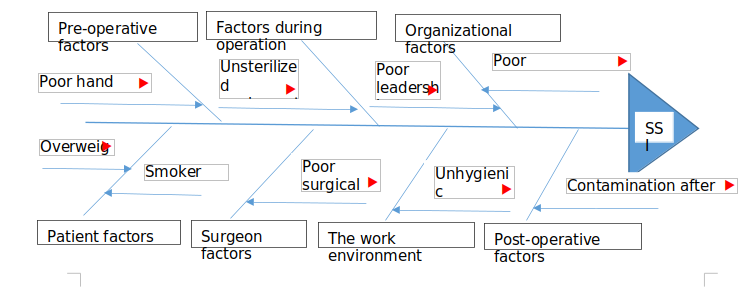Question
Consider a problem outcome that occurs frequently in your Microsystem. List the processes involved in producing this outcome, map the processes using a strategy such as the Fishbone diagram, and describe strategies for data collection on each of these process steps. Problem no- show for appointments. VA Hospital. Please include references.
Answer
Data Management
Fishbone diagrams help in cause-effect analysis of particular situations. Fishbone diagrams helps to critically analyze all aspects of a problem that might be the cause of a particular problem (Reilly, Myers, & Salvador et al., 2014). A common problem outcome in hip replacement and knee arthroplasty is Surgical Site Infection (SSI). This is a kind of infection that occurs on an individual within a period of up to 90 days following an operation. Among most patients, these infections typically occur within a month following an operation. The following are the processes involved in producing an SSI.
- Pre-operative factors.
- Factors during operation.
- Organizational factors.
- Factors contributed by the patient.
- Surgeon factors.
- The work environment.
- Post-operative care factors.
The following is a fishbone diagram of the problem outcome outlined above.

There are different strategies for data collection on each of the process steps in a Fishbone diagram. Data concerning pre-operative factors can be obtained from the National Surgical Quality Improvement Program (NSQIP) which is a program which was launched by the American College of Surgeons to collect pre-operative data (Acton, 2013). Data on factors during operation can be obtained from surveillance results obtained from the lead nurse. Data on organizational factors can be obtained through observation on various factors such as leadership at the hospital, financial constraints and other factors. Data on patient factors that contribute to SSI can be obtained through physically examining the patient. This can take the form of obtaining the medical history of the patient. Data on surgeon factors can be obtained through observation of the actual surgical procedure to determine if all protocols are observed. Data on work environment factors can be obtained from observing the physical operation environment including a review of various instruments such as air handling systems. Data regarding post-operative factors can be obtained from patients.
References
Acton, Q. A. (2013). Issues in Surgical Research, Techniques, and Innovation. 2013 Edition. New York, NY: ScholarlyEditions.
Reilly, J., Myers, J., Salvador, D., et al. (2014). Use of a novel, modified fishbone diagram to analyze diagnostic errors. Diagnosis, 1(2), pp. 167-171. Retrieved 10 Feb. 2016, from doi:10.1515/dx-2013-0040
Related: Clinical Immersion Project/Project Development Part A